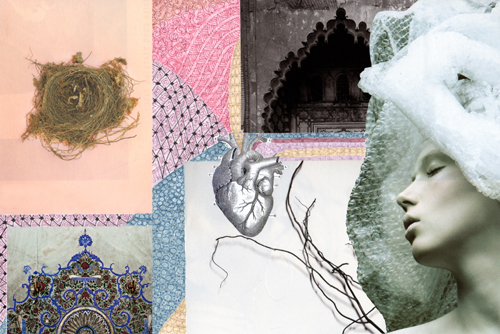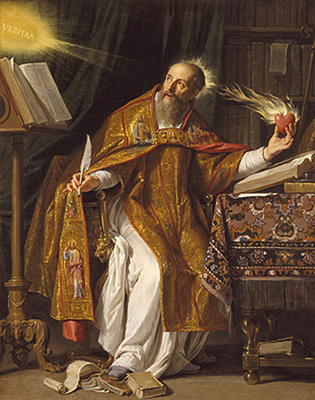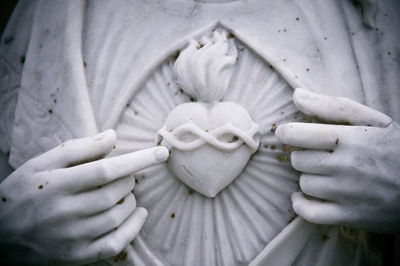
Michelle Casey, "Roots & Wings", Mixed Media Collage (marker, magazine fragments on Fabriano paper), 9 x 12 inches, April 2014
Last summer I found myself drawn to the symbol of the heart. While sifting through fragments, I was captivated by a drawing of an anatomical heart in Gray’s Anatomy; I decided that I’d like to use it to speak of the recent pain and loss I’d suffered. I put it aside hoping to find the perfect home for it in a piece. Since then I’ve been seeing heart-related imagery everywhere… in books, magazines, on clothing, Facebook and especially Pinterest. As a result, I was compelled to create a Pinterest Heart Board. I was curious to see the ways in which artists have been using this age-old symbol to convey their ideas and feelings about it. I’ve found hearts of steel, glass and stone; hearts blazing with fire and ones pierced by steely thorns. Some are romantic, others macabre. My favourite ones are steeped in ancient mythology and religion. In adding to my collection I found the practice of amassing hearts is just the tip of the iceberg. Its well worth following up collecting with additional research (whenever possible*) with the stories/histories behind the making of the symbols we use in our art. This will give us a better understanding of the ways in which they’ve been used for expression. I enjoy researching the symbols and visual fragments I use in my pieces; they never fail to lead me on exciting voyages of discovery; when I use them wisely, they give my work a greater impact. They also fuel future work. My research on the anatomical heart for instance led me to another important heart icon from my past.
For research on this heart, I began with my childhood memories. Growing up in a Roman Catholic family, I came to know this symbol as the “Sacred Heart”; a symbol of Christ’s love for humanity which appeared to me then as both a wondrous and morbid image. Its presence was felt in every room of our home: embedded within portraits of Christ and the saints; on prayer cards, rosaries and on the medals we wore beneath our clothes to protect us from the evil. While the anatomical heart speaks of its surface qualities and biological function, the Sacred Heart which spouts fire and is encircled by thorns, relays its inner human characteristics. For me the Sacred Heart has long been a sign of strength, courage and endurance: the ability to withstand life’s greatest obstacles. Like the “S” on Superman’s chest, the Sacred Heart enshrined within the bodies of religious figures reveals their invulnerability, their triumph over pain while simultaneously conveying their human frailty. Considering the state of my heart this past year, I’ve wondered if my mortal heart could ever possess the fantastic qualities of the hearts of the saints. So it was serendipitous to re-discover the positive sentiments behind the Sacred Heart. Uncovering a few of its related histories along the way has enabled me to envision my life in a more hopeful light. In this regard, I owe a great debt to painter Philippe de Champaigne whose portrait of Saint Augustin, replete with flaming heart in hand recently led me on an enlightening journey of self-reflection… perhaps one day I will tell you more about this.

Philippe de Champaigne, “Saint Augustin”, oil on canvas 31 x 24.5 inches, (1645-1650). Linking the heart, hand and mind, St. Augustin’s burning desire was the quest for knowledge and the truth.
Do you make reference to popular symbols in your work? If so, I’d love to hear a story behind your favourite symbol. If you haven’t considered researching symbols before, I hope I’ve aroused your curiosity into digging deeper into the icons you use.
* Note: I’ve found it isn’t easy to find background information on all images found on Pinterest particularly when they’ve come from sources such as Flickr.
Other Related Links:
Michelle Casey: Pinterest Heart Board
The Sacred Heart (Salt + Light Blog)
Punctured Artefact: Sacred Heart
Heart Symbols & Meaning: Hearts in Doodles
Augustine of Hippo (Wikipedia)
The One with a Hand: An Essay on Embodiment, Labor, and Alienation (Rizhomes)


Leave a Reply